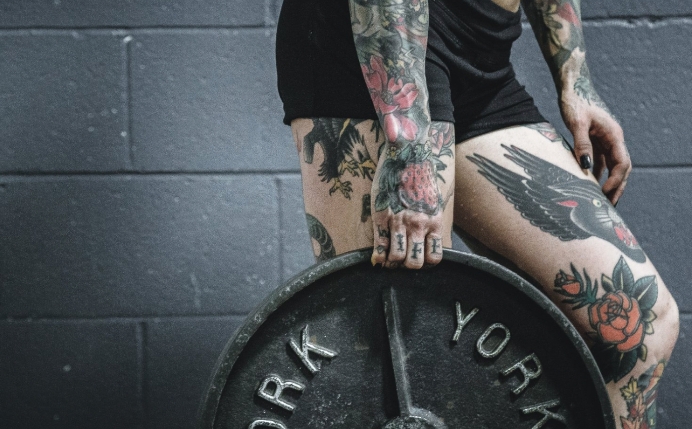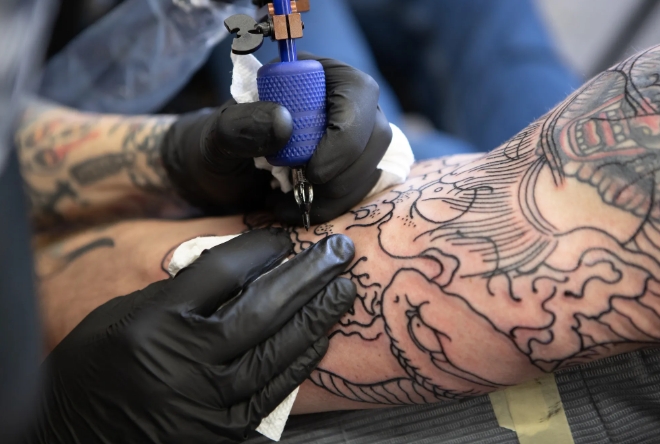Disclaimer: This article is for informational purposes only and does not constitute advice or recommendations. In case of any health concerns or symptoms, consult a doctor or qualified medical professional.
Tattoos are becoming increasingly popular in the modern world. For many, they are a form of self-expression, a tribute to fashion, or a nod to cultural traditions. However, anyone considering getting a tattoo must take several factors into account. One of these factors is physical activity after the procedure. The question of whether it’s safe to exercise immediately after getting a tattoo is particularly important for those leading an active lifestyle.
The Impact of Physical Activity on Tattoo Healing
How the Tattoo Healing Process Works
A tattoo, at its core, is a wound on the skin. The tattoo artist injects ink under the top layer of the skin using needles, creating a design. This process causes microtrauma to the skin, and the body needs time to recover. The average healing time for a tattoo ranges from one to four weeks, depending on the individual’s body and how well they care for the tattoo.
During this healing period, the tattoo is susceptible to the following risks:
- Inflammation
- Infection
- Loss of color vibrancy due to improper aftercare
Exercising can negatively impact the healing process for several reasons.
Factors That May Complicate the Healing Process
Sweat and Its Effect on Healing
During exercise, the body produces sweat, which consists of water, salts, and toxins. With active sweating, pores expand, allowing sweat and bacteria to enter the fresh wound. This increases the risk of tattoo infection. Additionally, the salt in sweat can irritate the skin, slowing the healing process and causing more pain at the wound site.
Friction from Clothing and Equipment
Physical activity, especially when wearing tight clothing or using sports equipment, can lead to friction in the tattooed area. This friction can not only irritate the skin but also shift the ink, negatively affecting the quality of the design. As a result, the tattoo may lose its vibrancy or even become deformed.
Stretching of the Skin
Exercises such as running, weightlifting, or yoga involve active muscle and skin movement and stretching. If the tattoo is located on a part of the body that undergoes intense movement (e.g., shoulder, back, thigh), this can interfere with the healing process. Stretching the skin around the tattoo may cause cracks or tears in the skin structure, which in turn can distort the tattoo’s outline.
Risks and Possible Consequences of Exercising After a Tattoo
Tattoo Infection
One of the primary risks of exercising immediately after getting a tattoo is the chance of infection. Since a tattoo is an open micro-wound, it provides an environment where harmful microorganisms can thrive. During workouts, bacteria can enter the tattoo through:
- Sweat
- Gym equipment
- Contact with other people
Infection can lead to various complications, ranging from mild inflammation to more severe skin conditions like folliculitis or abscesses.
Loss of Vibrancy and Tattoo Deformation
Exercise can also cause a loss of the tattoo’s original vibrancy. As mentioned earlier, friction from clothing or skin stretching during exercises can shift the pigment. As a result, the tattoo may lose its sharpness, colors may fade, and the design contours may distort.
This is especially relevant for larger tattoos or those covering significant areas of the body.
Slower Healing Process
Even if infection or mechanical damage is avoided, excessive physical activity can slow down the natural healing process. The body expends resources not only on skin recovery but also on muscle repair after exercise. This may result in the tattoo healing more slowly than usual, increasing the risk of scarring or defects.
Recommendations for Physical Activity After Getting a Tattoo
Minimum Recovery Period
Doctors and tattoo artists recommend refraining from intense physical activity for at least 48-72 hours after getting a tattoo. This time allows the skin to begin closing, and the first protective scab to form on the tattoo surface. It’s important to remember that this period may vary depending on the size and location of the tattoo.
Types of Exercise and Their Impact on the Tattoo
Cardio Workouts
Cardio workouts such as running, swimming, or using elliptical machines are associated with heavy sweating, which can negatively affect tattoo healing. Even if the workout doesn’t involve friction in the tattoo area, sweat can create a breeding ground for bacteria, increasing the risk of infection.
Strength Training
Strength training, particularly exercises targeting muscles near the tattoo, can stretch the skin and slow down the healing process. For example, if the tattoo is on the shoulder or arm, exercises for these muscle groups may cause pain or even skin tears.
Swimming
Swimming in pools or open water is strongly discouraged during the first two weeks after getting a tattoo. Pool water contains chlorine, which can irritate the skin and cause infections. Open water bodies, on the other hand, may harbor bacteria and germs, posing a risk to the healing tattoo.
Gradual Return to Exercise
It’s essential to return to physical activities gradually. Start with light exercises that don’t place much strain on the tattooed area. Make sure the skin is fully healed before resuming intense workouts.
A suggested recovery plan might look like this:
- Stage 1 (48-72 hours after getting the tattoo): complete rest, no physical activity.
- Stage 2 (3-7 days): light physical activities without sweating or intense friction.
- Stage 3 (7-14 days): return to regular workouts, avoiding exercises that impact the tattoo area.
- Stage 4 (after 2 weeks): full workouts, provided the tattoo has healed completely.
Tattoo Aftercare During the Healing Period
Basic Aftercare Rules
Proper tattoo aftercare during the first few weeks after getting it is crucial for how well it heals and how it looks long-term. It’s important to follow these recommendations:
- Regularly wash the tattoo with warm water and mild antibacterial soap.
- Avoid friction and contact with contaminated surfaces.
- Use special ointments and creams recommended by your tattoo artist.
- Don’t let the skin dry out, but avoid over-moisturizing.
Additional Precautions
In addition to the basic rules, consider the following:
- Avoid prolonged sun exposure. UV rays can cause sunburns and affect the tattoo’s pigmentation.
- Don’t pick at the scabs forming on the tattoo. This can cause scarring and disrupt pigmentation.
- Avoid saunas, baths, and pools for the first two weeks.
When Can You Return to Full Workouts?
Full return to exercise is only advisable after the tattoo has fully healed. Depending on individual body characteristics and the tattoo’s size, this process can take anywhere from two to four weeks. Before returning to intense workouts, it’s recommended to consult with your tattoo artist or a doctor to avoid complications.
The question of whether it’s safe to exercise immediately after getting a tattoo has many nuances. The main takeaway is that a tattoo requires proper care and time to heal. Physical activity can negatively affect this process, so it’s important to take precautions and hold off on exercising until the skin has fully recovered.




